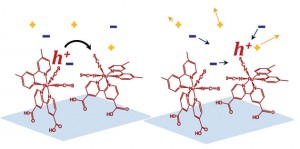Researchers in the UK, Spain and Switzerland say a method they have developed for probing electron transfer reactions could help them design more efficient solar cells.
Monitoring the behaviour of charges in photovoltaic devices is important for improving charge collection, especially in dye sensitised solar cells (DSSCs) that convert sunlight to electricity. Creating efficient solar cells is pivotal for meeting increasing energy demands especially as the world looks to move away from fossil fuels. DSSCs have many attractive features being simple to make, flexible and transparent, but they still have a way to go in terms of efficiency.
A research team led by Piers Barnes of Imperial College London has pioneered a technique that measures the diffusion coefficient of a less well reported phenomenon known as hole hopping, which occurs between sensitised dye molecules anchored to surfaces (in this case TiO2).
You can also read this article in Chemistry World
Read the original journal article in Chemical Science:
The reorganization energy of intermolecular hole hopping between dyes anchored to surfaces
Davide Moia, Valérie Vaissier, Ismael López-Duarte, Tomás Torres, Mohammad K. Nazeeruddin, Brian C. O’Regan, Jenny Nelson and Piers R. F. Barnes
Chem. Sci., 2014, Advance Article
DOI: 10.1039/C3SC52359D











